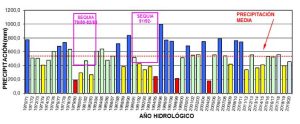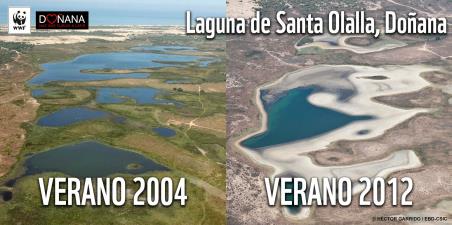Climate Detectives Projects 2022-2023
Project title: Another great drought
Team: Somos de ciencia
Ies Catedrático Pulido Rubio Bonares Spain 40 Student’s age: 16-17 years old
How are we affected by this great drought we are suffering?
¿Cómo nos afecta esta gran sequía que estamos sufriendo?

We will investigate the great drought that we are suffering in our region (Huelva) and how this lack of water affects or may affect the crops in our town and its surroundings, as well as natural spaces as important as the Doñana National Park.
The first thing to do will be to look for climatic data from the area to be studied from about 10 years ago until now, in order to
compare the data obtained.
We will also look for information on the water in the aquifers of the study area in recent years and analyse it.
Finally, we will analyse the data collected on the amount of water in the most important lagoons of the Doñana National Park and their repercussions on bird migration.
Investigaremos la gran sequía que estamos sufriendo en nuestra región (Huelva) y cómo esta falta de agua
afecta o puede afectar a los cultivos de nuestra localidad y sus alrededores, así como a espacios naturales
tan importantes como el Parque Nacional de Doñana.
Lo primero será buscar datos climáticos de la zona a estudiar desde hace unos 10 años hasta ahora, y así
comparar los datos obtenidos.
También buscaremos información sobre el agua de los acuíferos de la zona de estudio en los últimos años
y los analizaremos.
Y por último, analizaremos los datos recogido de la cantidad de agua que hay en las lagunas más
importantes del parque nacional de Doñana y su repercusión en la migración de las aves.

With all the data we have collected, we can conclude that the cultivation of red fruits in the area of Bonares and the Doñana national park, is not the most suitable, as all these plants need a large amount of water, either naturally by rainfall or through irrigation.we have been able to analyse the data of recent years of rainfall, and we note that due to the drought we suffer there is a deficit of water, both on the surface and in the subsoil.
This great demand for water for agriculture is obtained from the nearby aquifers, but due to the fact that it is raining less and less, this is a big problem. We are currently suffering from a great drought, in which we have been immersed for some years now, and the aquifers are getting lower and lower, due to the high extraction and the lack of recharge due to the lack of rain.
A clear consequence of this cultivation is the abuse of water abstraction from these aquifers. If we continue at this rate of water consumption, they will dry up.
This lack of surface water also affects the migratory birds that pass through the Doñana National Park on their migrations, as they do not find the ideal habitat to stop over on their way to warmer areas. We have observed that even the large lagoons that used to have water all year round are drying up.
Con todos los datos que hemos recogido, podemos concluir que el cultivo de los frutos rojos en la zona de Bonares y del parque nacional de Doñana, no es el más adecuado, ya que todas estas plantas necesitan una gran cantidad de agua, bien de forma natural por las lluvias o bien a través de los riegos.Hemos podido analizar los datos de los últimos años de las precipitaciones, y observamos que debido a la sequía que sufrimos hay un déficit de agua, tanto en superficie como en el subsuelo.
Esta gran demanda de agua para la agricultura, se obtiene de los acuíferos cercanos, pero debido a que cada vez llueve menos, esto es un gran problema. En la actualidad estamos sufriendo una gran sequía, en la que llevamos inmersos ya unos años, y cada vez los acuíferos están a un nivel más bajo, debido a la gran extracción y la falta de recarga por falta de lluvia.
Una consecuencia clara de este cultivo es el abuso de extracciones de agua de dichos acuíferos. Si seguimos a este ritmo de consumo de agua, se secarán.
Esta falta de agua en superficie, afecta también a las aves migratorias que pasan por el Parque nacional de Doñana en sus migraciones, ya que no encuentran el hábitat idóneo para hacer escala en su trayecto a zonas más cálidas. Observamos que se están secando incluso las grandes lagunas que hace años se mantenían con agua durante todo el año.
An alternative would be to change cultivation, as was done a few years ago, and return to the original dry farming, typical of this area of Huelva. This crop is more adapted to our climate and requires less water.
The use of surface water is another alternative, but this would only be possible in years with sufficient rainfall. When we are in years of drought, as we are now, and which are becoming more and more frequent, surface water accumulations are either non-existent or too scarce for the great demand for water that farmers need.
Una alternativa sería cambiar de cultivo, como se hizo ya hace unos años, y volver al cultivo original de secano, típico de esta zona de Huelva. Cultivo este más adaptado a nuestro clima y con menos requerimientos de agua.
El uso de aguas superficiales es otra alternativa, pero esta sería posible sólo los años de suficiente lluvia. Cuando estemos en años, como en el que nos encontramos, y que cada vez son más frecuentes, de sequía, las acumulaciones de agua superficiales no hay o son muy escasas para la gran demanda de agua que necesitan los agricultores.
Informe-de-Otra-gran-sequia.pdf
This project was automatically translated into English.
Projects are created by the teams and they take the full responsibility of the shared data.
← All projects




